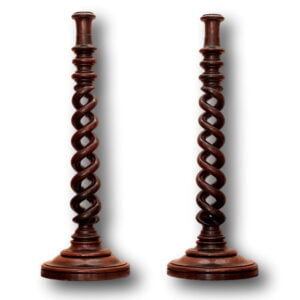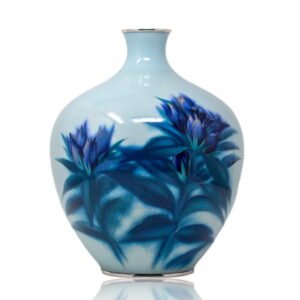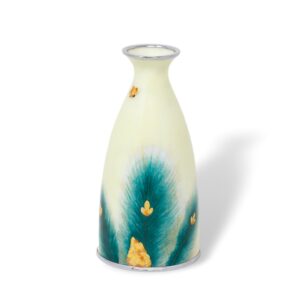Description
White Rose
From our Japanese collection, we are delighted to present this Japanese Cloisonné Enamel Vase by the Ando Company.
The vase is of globular form with a tightly pinched neck and splayed opening. It is decorated with a striking red enamel ground, worked in both wired cloisonné and musen shippō (wireless technique). The central motif features a white rose with yellow-tipped petals, surrounded by stylised red leaves, standing out in high contrast against the deep background.
The vase is finished with silver mounts, the rim stamped with the Jungin (純銀) mark for pure silver. The base is further enamelled with the Ando Company mark, confirming its distinguished origin.
Dating to the early Showa period, circa 1940, this piece represents the refined output of one of Japan’s most important cloisonné workshops.
Provenance
Sourced from a UK single owner collection of mid century Japanese Cloisonne Enamel.
ANDO CLOISONNE COMPANY (安藤七宝店)
The Ando Cloisonné Company, founded in Nagoya in 1880, is one of Japan’s leading cloisonné enamel workshops. Known for pioneering techniques such as musen (wireless) cloisonné and plique-à-jour, Ando earned Imperial patronage and international acclaim. Today, the firm continues to produce exceptional cloisonné, preserving Japan’s rich enamel tradition while showcasing its artistry worldwide. See our makers and retailers page on the Ando Cloisonné Company (安藤七宝店)for further information.
CLOISONNE
Cloisonné is a traditional decorative art that involves applying thin metal wires to form compartments (cloisons) on a metal surface, which are then filled with colourful enamel. After multiple firings and polishings, the result is a vibrant, glass-like finish with intricate designs. The technique has roots in ancient China but was perfected in Japan during the Meiji period (1868–1912), often referred to as the Golden Age of Cloisonné. Japanese artists developed advanced methods such as musen shippō(wireless cloisonné) and shōtai shippō (plique-à-jour), creating seamless, naturalistic, and even translucent effects. Highly prized for its precision, artistry, and beauty, Japanese cloisonné is regarded as one of the finest forms of enamel craftsmanship in the world and remains highly collectible today. See our post The Art of Japanese Cloisonné: History, Craftsmanship, and the Golden Age for further information.
SHOWA PERIOD (1926–1989)
The Showa era, under Emperor Hirohito, was a time of dramatic change in Japan. Spanning pre-war militarism, post-war recovery, and the “Japanese Economic Miracle,” the period reshaped both culture and craftsmanship. In the arts, traditional skills such as cloisonné, ceramics, and lacquerware adapted to modern tastes, balancing heritage with new design influences. Today, Showa-period works are valued for their blend of tradition and innovation, offering collectors a direct link to Japan’s transformation in the 20th century. See our post The Shōwa Period in Japan: From Turbulence to Transformation for further information.
WIRELESS CLOISONNÉ (MUSEN SHIPPŌ)
Wireless cloisonné, or musen shippō (無線七宝), is a Japanese enamel technique developed in the late 19th century and perfected during the Meiji and Showa periods. Unlike traditional cloisonné, where metal wires form visible compartments, the musen method removes the wires during firing. This leaves smooth fields of colour and seamless transitions, allowing for more natural or abstract designs.
The technique was pioneered by masters such as Namikawa Sōsuke and later advanced by workshops like the Ando Company. It became especially popular in the early 20th century, often used for modern floral motifs and bold geometric decoration. Today, musen shippō is highly regarded for its technical difficulty and striking visual effect, making it one of the most collectible forms of Japanese cloisonné enamel.
Enamel (vitreous enamel)
also known as porcelain enamel, is a material made by fusing powdered glass to a substrate by firing, usually between 750 and 850 °C. The powder melts, flows, and then hardens to a smooth, durable vitreous coating. The word vitreous comes from the Latin vitreous, meaning “glassy”.
Measurements
18cm High x 19cm Diameter (7 x 7.5 Inches )
Condition
Excellent Condition, minor wear consistent with age, no damage or restoration
With every purchase from Jacksons Antique, you will receive our latest product guide, certificate of authenticity, full tracking information so you can monitor your shipment from start to finish and our personal no-hassle, money-back policy giving you that extra confidence when purchasing. Don’t forget to sign up to our free monthly newsletter for 10% off your first online purchase.

















